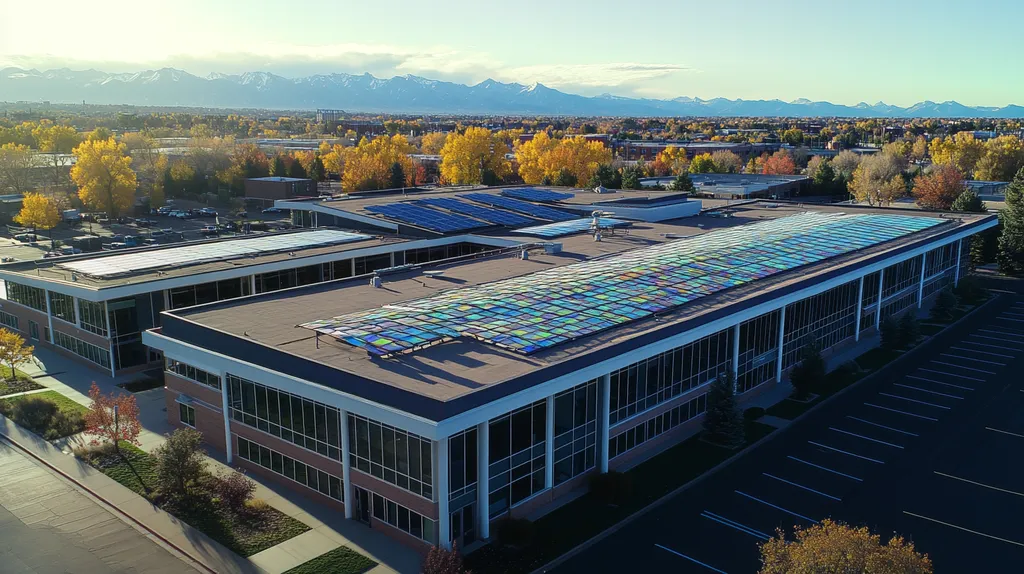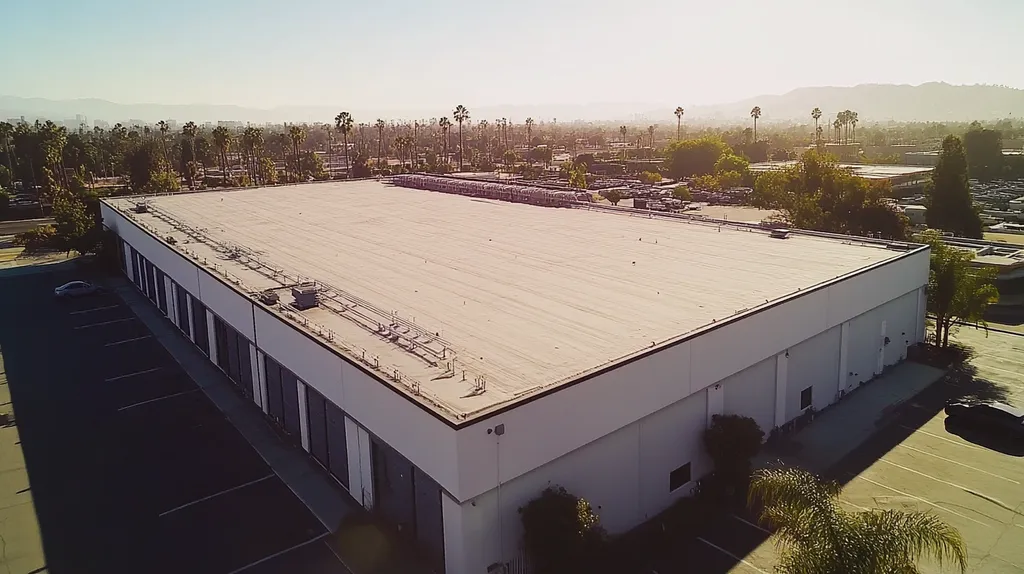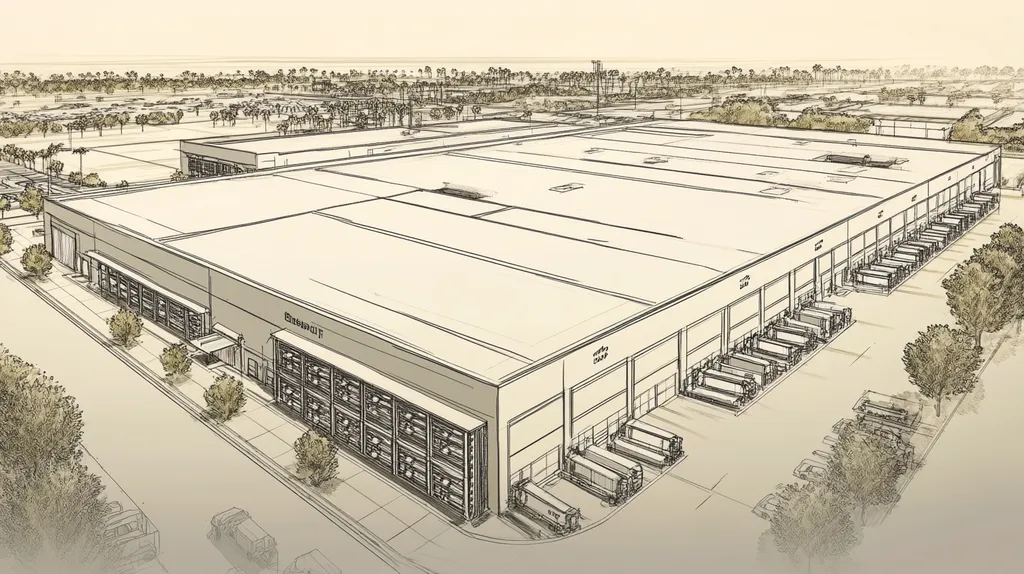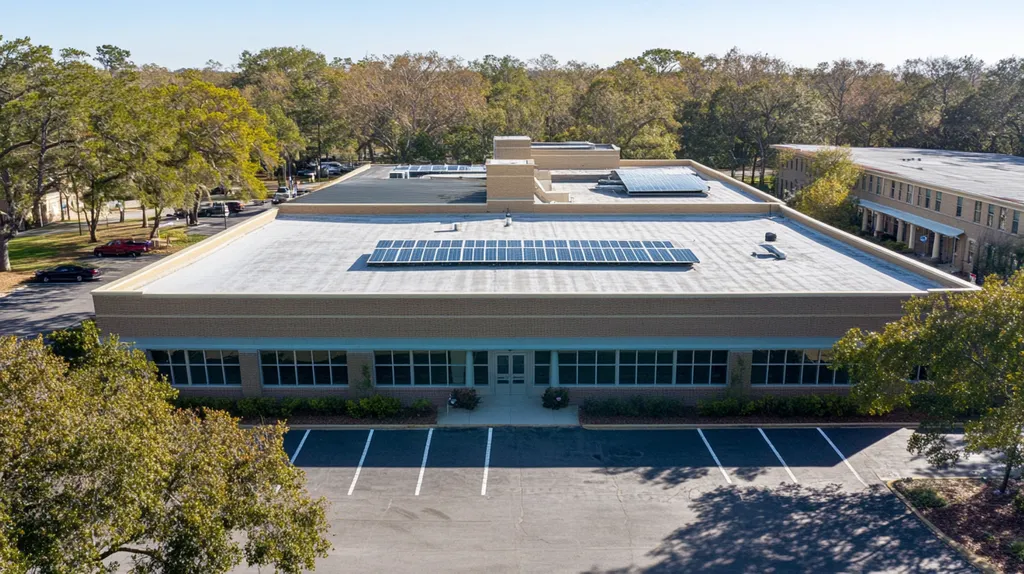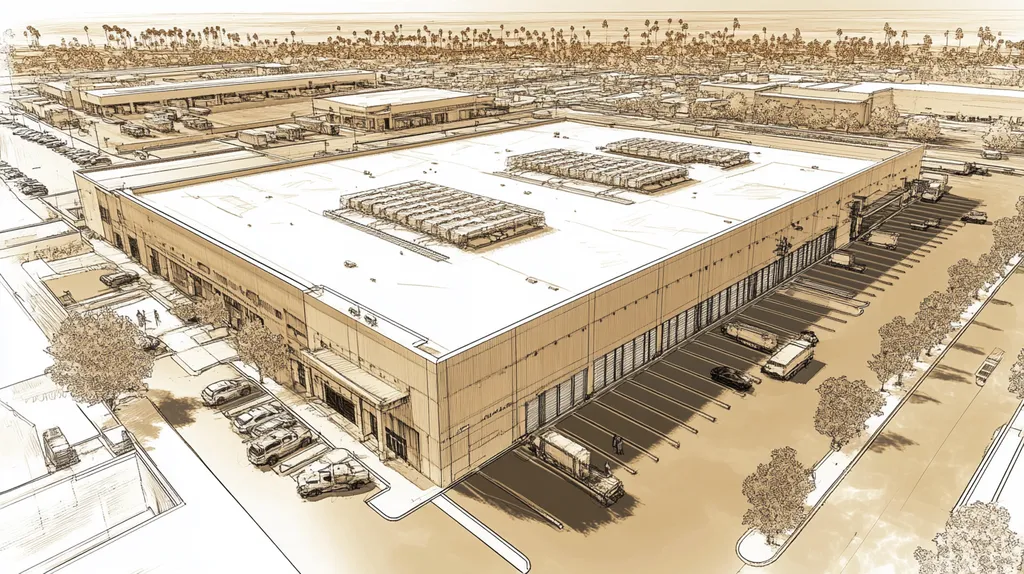Each year, commercial building fires cause over $2.4 billion in property damage and devastating loss of life – yet many facilities continue to operate with outdated or inadequate fire protection systems.
The relationship between roof design and fire suppression effectiveness can mean the difference between a contained incident and catastrophic loss.
This comprehensive guide examines the critical intersection of commercial roofing systems and fire safety, exploring how material choices, system integration, and proper maintenance work together to protect both property and lives.
From fundamental fire resistance concepts to advanced optimization strategies, facility managers and property owners will discover actionable insights for enhancing their buildings’ fire safety profile.
SECTION 1: FUNDAMENTAL CONCEPTS
Fire safety in commercial roofing transcends mere compliance; it is an essential safeguard that protects lives and property. In the U.S., over 100,000 commercial building fires occur annually, leading to devastating financial and emotional losses. Grasping fire resistance ratings, the fire properties of roofing materials, and pertinent regulatory standards is crucial for property owners and facilities managers. This section lays out the foundational knowledge necessary for making informed roofing decisions that significantly enhance fire safety.
Fire Resistance Ratings and Classes
Fire resistance ratings categorize roofing materials by their ability to withstand fire. These classifications range from Class A, which affords the highest protection, to Class C, which offers minimal resistance. Class A materials can endure flames for extended periods, effectively reducing the risk of fire spreading to the interior of the building.
Examples of Class A materials include modified bitumen and select metal roofs. Choosing these materials not only enhances safety but can also lead to lower insurance premiums due to improved safety ratings. Understanding these classifications empowers property owners to select options that prioritize maximum safety and compliance.
In contrast, the selection of Class C materials presents significant risks in the event of a fire. Low-rated materials can ignite rapidly, facilitating faster fire spread. By prioritizing materials with higher fire resistance ratings, property owners can mitigate these inherent risks, safeguarding both their assets and occupants.
Collaborating with experienced roofing professionals is vital for selecting appropriate materials that align with fire safety practices. This engagement not only assures compliance but also helps maintain the building’s long-term integrity.
Roofing Materials and Their Fire Properties
The fire properties of roofing materials play a pivotal role in a building’s overall fire safety. Common commercial roofing materials like TPO, EPDM, and metal exhibit varying levels of fire resistance. Metal roofs typically offer exceptional fire performance, while TPO and EPDM can provide diverse ratings depending on their specific formulations.
Property owners must understand the composition of these materials to make knowledgeable choices. For example, incorporating fire-retardant treatments can enhance the fire resilience of certain roofing systems, offering an additional layer of safety. Assessing the costs and benefits of these treatments is crucial.
Moreover, how roofing materials work in conjunction with other building components—such as insulation and underlayment—can directly impact fire behavior. When selecting roofing materials, property owners should consider the entire roofing assembly and its interaction with potential fire hazards.
Ultimately, choosing the right roofing material can significantly affect a building’s vulnerability to fire. Decision-makers must familiarize themselves with these materials and collaborate with experts to ensure a holistic fire safety strategy.
Regulatory Standards for Fire Safety
Regulatory standards are the backbone of fire safety in commercial roofing systems. Organizations like the National Fire Protection Association (NFPA) and Underwriters Laboratories (UL) set forth guidelines that assess fire resistance in roofing materials. Compliance with these standards is not just a matter of regulation; it serves a crucial role in mitigating fire risks.
For instance, roofing assemblies often need to satisfy specific fire test criteria as detailed in the NFPA 255 standard, which measures the spread of flame across material surfaces. Property owners and facility managers should be aware of local codes and regulations applicable to their buildings to ensure compliance.
Neglecting these regulations can lead to serious consequences, including legal liability and an increased likelihood of loss during a fire. Therefore, staying educated about evolving regulatory standards and fire safety advancements is essential for property managers.
Staying informed provides property owners a compliance edge while enhancing the safety reputation of their buildings. Working with industry professionals who are attuned to these changing regulations can offer invaluable assistance in fostering a safe environment.
SECTION 2: SYSTEM COMPONENTS
Understanding the components of a fire suppression system is crucial for protecting commercial properties from devastating losses. An effective roofing system serves as the first line of defense against fire-related incidents. Research shows that buildings without fire-resistant materials face a much higher risk of severe damage during fires. In this section, we will explore essential fire-resistant roofing materials, the indispensable role of sprinkler systems, and the integration of alarm and detection systems to create a robust fire safety strategy.
Fire-Resistant Roofing Materials Overview
Selecting the right roofing materials is not just important—it’s vital for fire safety in commercial buildings. Fire-resistant roofing options, including metal, modified bitumen, and specific types of tiles, significantly slow down the spread of flames. For example, metal roofs are capable of withstanding high temperatures and are less likely to ignite compared to conventional asphalt shingles.
These materials are rigorously tested to comply with national fire codes, ensuring their reliability. Facilities managers should prioritize roofing materials that not only meet local regulations but also align with national safety standards. This careful selection can drastically reduce fire-related risks and enhance overall building security.
Durability is another essential factor for fire-resistant roofing materials. High-performing options can withstand unexpected stressors, helping to minimize potential damage and save costs over time. Investing in quality roofing materials leads to long-term peace of mind and contributes to the building’s resilience against fire hazards.
Regular inspections are equally important. Over time, wear and tear can diminish a roof’s fire-resistance capabilities. Establishing a maintenance schedule ensures that the roofing system remains compliant and effective in the event of a fire incident.
Role of Sprinkler Systems in Fire Suppression
Sprinkler systems are a cornerstone of fire suppression strategies for commercial properties. These systems can extinguish flames before they spread, significantly curtailing damage and loss. Buildings equipped with automatic fire sprinklers enjoy a remarkable 50% reduction in fire-related destruction when compared to those lacking such systems.
The effectiveness of any sprinkler system relies on proper installation and routine maintenance. Sprinklers must be strategically positioned to ensure coverage of all key areas, guaranteeing their effectiveness during emergencies. Regular testing is essential to confirm that the entire system is functional and poised to respond when needed.
Importantly, the type of roofing material can enhance or hinder a sprinkler system’s performance. Fire-resistant materials create a buffer against flames, allowing sprinklers to operate more effectively. This synergy plays a crucial role in reinforcing the building’s overall fire safety.
Training staff about the correct operation of sprinkler systems is also essential. Facility managers should conduct drills and educate team members on the critical nature of these systems during fire emergencies. Well-informed personnel can respond quickly, significantly improving safety outcomes.
Alarm and Detection System Integration
Alarm and detection systems are indispensable allies in a comprehensive fire safety plan, working in concert with roofing and sprinkler solutions. These systems detect heat and smoke, providing early warnings that save lives and lessen damage. Statistics indicate that buildings with fully integrated fire alarm systems experience far fewer significant losses during fires.
Integrating detection systems with sprinklers enhances response times dramatically. When a smoke alarm is triggered, it can activate the sprinklers almost instantly. This rapid response is critical in containing a fire before it escalates, highlighting the importance of seamless technology integration.
Investing in advanced alarm technologies is vital to ensure detection systems are both reliable and effective. Routine maintenance and testing are imperative to keep these systems functioning optimally. Facility managers should implement a regular inspection schedule to ensure that alarms and detectors are always operational.
Additionally, training staff to respond appropriately to alarms and adhere to fire evacuation protocols fosters a culture of safety. Clear communication strategies should be established so that every employee knows how to react when an alarm sounds. This preparedness is vital for minimizing the impact of any fire-related incident.
SECTION 3: IMPLEMENTATION METHODS
As commercial properties experience rising fire risks, the design and installation of fire-resistant roofing systems have become more critical than ever. With over 15,000 commercial structure fires reported each year in the U.S., effective roofing plays a vital role in reducing potential devastation. High-quality roofs not only withstand flames but also enhance the performance of fire suppression systems. This section delves into key methods for designing fire-resistant roofs, installing materials like modified bitumen and metal, and incorporating rooftop sprinkler systems.
Designing Fire-Resistant Roofing Systems
Designing fire-resistant roofing systems is crucial for safeguarding commercial properties against flames. Architects and engineers must choose materials that meet high fire ratings, such as Class A or B insulation and roofing coverings. These ratings reflect how well materials can withstand flames, effectively reducing the speed at which fires spread.
Incorporating non-combustible materials like fiber cement or metal significantly boosts a roof’s fire resilience. These materials resist ignition, helping to protect the building’s structure. Additionally, the use of fire-resistant membranes can block flames from penetrating the roof assembly, offering further security.
While building codes can differ from one region to another, adhering to national safety standards is essential for enhancing fire safety. Regular consultations with local fire marshals can ensure compliance, optimizing designs for both aesthetics and performance.
Ultimately, a well-thought-out fire-resistant design protects occupants and helps property owners lower insurance costs while reducing the risk of potential legal liabilities.
Installing Modified Bitumen and Metal Roofs
Choosing modified bitumen and metal roofs can be highly effective in boosting fire resistance for commercial buildings. Modified bitumen, a blend of asphalt and polymers, boasts strong fire ratings and installation flexibility, allowing it to adapt to diverse roof shapes and reducing weak spots.
Metal roofs, celebrated for their durability, are inherently fire-resistant. With proper installation and appropriately rated underlayments, metal roofs can endure high temperatures without sacrificing structural integrity, making them ideal for fire-prone regions.
Effective installation methods for both materials are critical to achieving their fire-resistant benefits. Proper sealing and overlapping of seams prevent gaps that may allow flames or heat to infiltrate. For optimal results, it is wise to work with contractors who specialize in fire-resistant installations.
By selecting these materials and ensuring their proper installation, property owners can significantly diminish fire risks and bolster their buildings’ overall resilience.
Integrating Rooftop Sprinkler Systems
Integrating rooftop sprinkler systems into commercial roofing designs provides an invaluable layer of fire protection. These systems effectively manage fires at their source, often halting flames from spreading to other areas of the building. When correctly installed, rooftop sprinklers can lead to a reduction in fire-related damage of over 60%.
Strategic placement of sprinklers is essential; they should be positioned based on potential fire hazards, such as HVAC systems or fuel sources. Working alongside fire safety experts ensures that the system achieves adequate coverage and functionality.
Connection to a reliable water source is also critical for rooftop sprinklers to function efficiently. Regular maintenance checks are necessary to keep all components in working order. Flushing pipes and testing water pressure helps ensure performance during emergencies.
Incorporating these systems not only enhances safety but may also lower insurance premiums, making them a prudent investment for property owners. By combining fire-resistant roofing with effective sprinkler systems, commercial buildings can reach higher safety and compliance standards.
SECTION 4: MAINTENANCE REQUIREMENTS
Regular maintenance of a commercial roof design and its accompanying fire suppression system is not just advisable—it’s essential for safeguarding both people and property. Research indicates that roofs receiving consistent inspections face a much lower risk of severe damage or fire incidents. Ensuring that roofs and fire suppression systems operate at their best minimizes financial liability and protects vital assets.
Regular Inspection and Testing Protocols
Establishing a consistent schedule for inspections and testing is vital for commercial roofs and fire suppression systems. Routine assessments help identify potential vulnerabilities before they develop into larger problems. For example, bi-annual roof inspections can reveal issues like water pooling or membrane damage that may lead to costly repairs down the line.
In addition to visual inspections, it is crucial to perform annual tests on fire suppression systems, in line with National Fire Protection Association (NFPA) standards. These tests should cover sprinklers, alarms, and extinguishers. Engaging a certified technician for these evaluations ensures compliance with regulations and confirms system functionality.
Documenting findings from both inspections and tests is essential. This information not only aids in tracking roof conditions but also provides a reliable record for future repairs or insurance claims. Having thorough maintenance logs can ultimately save property owners significant costs by extending the lifespan of roofs and fire suppression systems.
Property owners should be attuned to local regulations that may mandate more frequent inspections for certain high-risk facilities. Understanding these specific codes is crucial for maintaining compliance while reinforcing safety measures. Planning inspections well in advance keeps critical systems operational and effective.
Maintenance of Fire Suppression Components
The effectiveness of fire suppression systems hinges on their maintenance. Consistent upkeep is essential to ensure these systems respond appropriately during emergencies. For instance, regular inspections of a sprinkler system’s water flow and pressure are necessary to verify readiness during a fire.
Furthermore, it is important to ensure that the nozzles and piping remain clear of obstructions. Over time, debris or corrosion can accumulate, significantly reducing system effectiveness and posing a serious risk during a fire. Neglecting these aspects could endanger lives and property.
Access to fire suppression equipment must also be maintained. Regular checks should confirm that alarms are operational and marked clearly. Implementing a maintenance schedule that includes these elements is a proactive measure in preserving safety.
Working with knowledgeable service providers can elevate the quality of maintenance performed. Experts possess the technical skills necessary to conduct thorough assessments and execute repairs or replacements efficiently. Investing in professional maintenance ensures that safety standards are not just met, but exceeded.
Addressing Common Issues and Repairs
No matter how diligent an inspection routine may be, issues will arise. Common problems such as leaks or membrane punctures should be addressed immediately to prevent further damage. Ignoring these signs can lead to significant structural concerns and expensive repairs later on.
For instance, even a minor leak can cause mold growth, jeopardizing indoor air quality and potentially harming occupants’ health. Quick repairs not only protect assets but also demonstrate to occupants that their safety is a foremost priority. Keeping records of these repairs also emphasizes a commitment to maintenance.
Another prevalent concern is debris accumulation on roofs. This can trap moisture and create conditions conducive to leaks and rot. Regularly clearing gutters and roof surfaces is a simple yet effective maintenance task that can prevent larger issues from developing.
Proactive management of aging materials is equally important. Establishing a robust replacement schedule for components like insulation or membranes can optimize efficiency and ensure ongoing compliance with safety regulations. This foresight significantly reduces the likelihood of unexpected system failures.
SECTION 5: PERFORMANCE METRICS
Understanding the performance metrics of fire suppression systems in commercial roofing is essential for safeguarding both property and lives. Insufficient systems can result in devastating consequences, as studies have shown that buildings lacking fire-resistant roofing sustained up to 40% more damage during fires. By closely monitoring performance metrics, property owners can ensure their fire protection measures are effective. This section evaluates fire resistance in real-world scenarios, measures system effectiveness during wildfires, and assesses structural damage and loss prevention.
Evaluating Fire Resistance in Real-World Scenarios
To truly understand fire resistance, evaluations must occur under actual fire conditions, not just controlled tests. Many systems may successfully pass laboratory assessments but falter during real incidents. For instance, a recent fire in a commercial kitchen resulted in a total loss for a facility that had a non-rated roof, demonstrating the need for roofs that can endure high temperatures and external fire threats.
Using metrics aligned with National Fire Protection Association (NFPA) standards enables thorough evaluation. Documenting past fire events and their impact on various roofing materials helps property owners make informed choices. Familiarity with fire ratings enhances preparedness against possible threats and informs future decisions.
Moreover, the passage of smoke and heat through structural elements can jeopardize safety. Evaluating fire-resistance ratings can predict such incidents, allowing for proactive solutions to be implemented. Regular assessments and strategic upgrades should be integral to any comprehensive fire prevention plan.
By investing in higher-rated materials and diligently adhering to fire codes, property owners can significantly lower their risks. Prioritizing these evaluations is essential for protecting investments and ensuring the safety of all occupants.
Measuring System Effectiveness in Wildfires
Wildfires present distinct challenges for commercial roofing systems, particularly for properties in high-risk areas. Research indicates that buildings featuring fire-suppressive roofing materials incur 60% less damage during wildfires than those without such protections. Therefore, properly assessing system effectiveness is crucial.
Factors to consider include a material’s thermal resistance, flame spread characteristics, and the ability to prevent water intrusion. Roofs designed with these qualities can impede or extinguish fires before they breach interior spaces. For example, utilizing Class A materials greatly enhances a roof’s ignition resistance.
Furthermore, integrating active fire suppression measures, such as sprinkler systems, can complement roofing strategies. This coordination is vital for maximizing the overall effectiveness of fire safety initiatives. Property owners must familiarize themselves with these principles to provide optimal protection against wildfires.
In addition to building resilience, creating defensible spaces through proactive landscaping can further strengthen roof performance against wildfires. Ongoing maintenance and thorough assessments ensure that all components are functioning properly when emergencies arise.
Assessing Structural Damage and Loss Prevention
Accurately assessing structural damage and implementing effective loss prevention measures are crucial tasks for every commercial property owner. Fires can inflict significant harm—beyond just physical damage, they threaten business continuity and financial stability. An effective fire suppression system should minimize damage not only to the roof structure but also to internal assets.
Understanding both direct damage and the indirect costs associated with lost revenue during repairs facilitates accurate loss quantification. Studies indicate that commercial buildings equipped with advanced fire containment features can reduce recovery times by up to 30%, further underscoring the value of investing in robust fire suppression systems.
Additionally, reviewing past fire incidents can provide invaluable insights for improving current roofing designs and fire strategies. Conducting regular inspections and making timely updates can greatly lessen vulnerability to fire damage. Developing comprehensive building inventories and recovery plans is also essential to mitigating losses during incidents.
Fostering a culture of safety and preparedness pays dividends. Training employees on proper fire response protocols assists in minimizing damage until professional help arrives. It is essential for property owners to recognize the importance of comprehensive assessments—these are vital for protecting their assets against possible fire hazards.
SECTION 5: PERFORMANCE METRICS
Understanding the performance metrics of fire suppression systems in commercial roofing is critical for protecting both property and lives. The stakes are high—studies reveal that buildings with subpar fire-resistant roofing endured 40% more damage during fires. Monitoring these metrics closely helps ensure that fire protection measures are effective. In this section, performance will be evaluated in real-world scenarios, system effectiveness during wildfires will be assessed, and structural damage and loss prevention strategies will be explored.
Evaluating Fire Resistance in Real-World Scenarios
Fire resistance assessments must reflect real-world conditions. While many systems meet laboratory standards, they can fail in actual fires. A recent incident exemplified this: a commercial kitchen fire resulted in total loss for a facility with a non-rated roof. This underlines the necessity for roofs engineered to withstand high temperatures and external fire threats.
Utilizing metrics established by the National Fire Protection Association (NFPA) enables rigorous evaluations. Documenting previous fire events and analyzing the performance of various roofing materials allows property owners to make informed, strategic decisions. A robust understanding of fire ratings enhances preparedness against potential threats.
Moreover, the passage of smoke and heat through structural elements can compromise safety. Regular evaluations of fire-resistance ratings help predict vulnerabilities and enable timely, proactive measures. Upgrades should be integral to any comprehensive fire prevention strategy.
Investing in higher-rated materials, while adhering to fire codes, can significantly reduce risks. Property owners must prioritize these evaluations, as they are crucial for protecting investments and ensuring occupant safety.
Measuring System Effectiveness in Wildfires
Wildfires present unique challenges for commercial roofing systems, especially for properties situated in high-risk areas. Research shows buildings equipped with fire suppressive roofing materials incur 60% less damage during wildfires compared to those without. Therefore, assessing system effectiveness becomes vital.
When evaluating effectiveness, property owners should consider factors like thermal resistance, flame spread characteristics, and water intrusion prevention capabilities. Roofs designed with these attributes can slow down or extinguish fires before they reach the interior. For instance, using Class A materials markedly enhances a roof’s ignition resistance.
Integrating active fire suppression measures, such as sprinkler systems, further complements roofing strategies. This unified approach is essential for maximizing fire safety effectiveness. Property owners should actively seek to understand and apply these principles for enhanced protection.
In high-risk regions, proactive landscaping and creating defensible spaces can enhance roofing performance against wildfires. Regular maintenance and systematic assessments ensure that all components operate effectively when emergencies occur.
Assessing Structural Damage and Loss Prevention
Assessing structural damage and implementing loss prevention strategies are crucial responsibilities for commercial property owners. The ramifications of a fire extend beyond immediate destruction; they also threaten business continuity and financial viability. Effective fire suppression systems must seek to minimize damage to both the roofing structure and internal assets.
Understanding both direct damage and the indirect costs associated with lost revenue during repairs is essential for accurate loss quantification. Studies indicate that commercial buildings with advanced fire containment features can reduce recovery times by up to 30%, underscoring the benefits of investing in robust fire suppression systems.
Additionally, reviewing past fire incidents provides valuable insights for enhancing current roofing designs and fire strategies. Regular inspections and timely updates significantly limit vulnerability to fire damage. Comprehensive building inventories and recovery plans are integral to minimizing losses.
Creating a culture of safety and preparedness also offers significant rewards. Training employees on effective fire response protocols can assist in immediate mitigation efforts, leading to reduced damage until professional assistance arrives. Recognizing the importance of comprehensive assessments is vital for property owners aiming to safeguard their assets against potential fire threats.
The Bottom Line
With commercial building fires causing over $2.4 billion in annual damages, the integration of proper roof design and fire suppression systems remains critically urgent for every property owner.
Research demonstrates that buildings with optimized fire-resistant roofing and suppression systems reduce fire damage by up to 60% compared to structures with standard materials.
The relationship between roofing design, material selection, and fire suppression effectiveness directly impacts both safety outcomes and financial losses during emergencies.
By implementing the strategies outlined in this guide – from material selection to maintenance protocols – facility managers can significantly enhance their buildings’ fire safety profiles while meeting regulatory requirements.
The stakes are simply too high to delay these essential safety improvements any longer.
FREQUENTLY ASKED QUESTIONS
Q. Why are fire resistance ratings crucial for commercial roofs?
A. Fire resistance ratings are essential because they indicate how well roofing materials can withstand flames. Choosing materials with higher ratings, like Class A, significantly reduces the risk of fire spreading and protects both occupants and property. This knowledge empowers property owners to make informed choices that prioritize safety.
Q. How do fire suppression systems enhance a commercial roof’s safety?
A. Fire suppression systems, like sprinklers and alarms, significantly enhance safety by quickly detecting fires and extinguishing them before they spread. This proactive approach minimizes damage and protects lives. When integrated with fire-resistant roofing, these systems create a comprehensive safety strategy for commercial properties.
Q. What factors should I consider when designing a fire-resistant roof?
A. When designing a fire-resistant roof, consider material selection, insulation ratings, and compliance with fire codes. Utilizing materials like metal and modified bitumen enhances resistance to flames and heat. Consulting with fire safety experts ensures that your design meets both regulatory standards and practical safety needs.
Q. How often should I inspect my commercial roof and fire suppression systems?
A. Commercial roofs and fire suppression systems should undergo regular inspections at least bi-annually. These inspections help identify vulnerabilities early on and conduct necessary maintenance. Ensuring that these systems remain operational can significantly reduce risks and enhance the overall safety of your building.
Q. What common issues should I address during roof maintenance?
A. During maintenance, address common issues such as leaks, membrane punctures, and debris accumulation. Promptly resolving these problems prevents further damage and ensures that your roof remains functional and compliant with safety regulations. Regular upkeep also extends the longevity of your roofing system and fire suppression measures.
Q. How can performance metrics inform my fire safety strategy?
A. Monitoring performance metrics helps assess how effective your fire safety measures are. By evaluating fire resistance in real-world scenarios and analyzing system performance during emergencies, you can identify vulnerabilities and enhance strategies. These insights are vital for continuously improving the safety of a commercial property.
Q. What additional factors improve fire safety in commercial roofing?
A. Additional factors include choosing the right insulation, ensuring proper drainage, and using fire-retardant coatings. Consulting with roofing professionals about design, material choices, and regular maintenance schedules further enhances overall fire safety. Each decision contributes to the durability and reliability of fire safety systems within commercial roofing.


